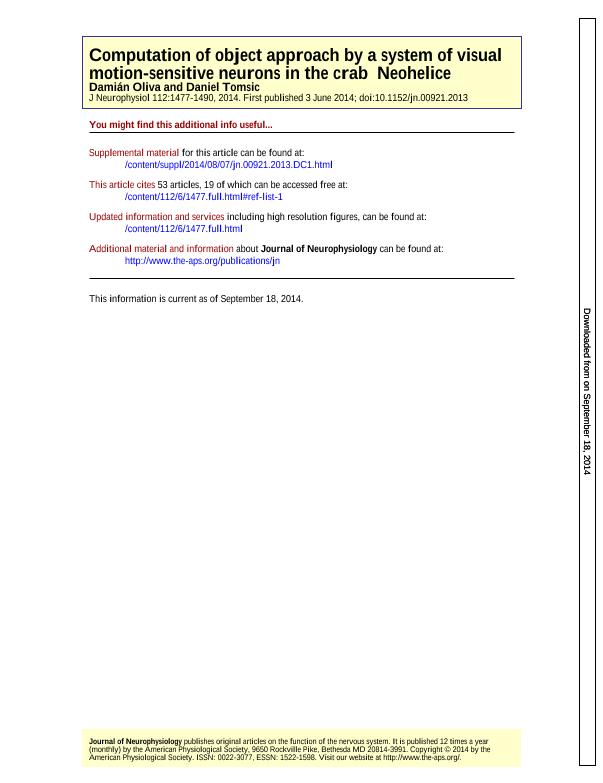Mostrar el registro sencillo del ítem
dc.contributor.author
Oliva, Damian Ernesto

dc.contributor.author
Tomsic, Daniel

dc.date.available
2017-12-28T17:46:10Z
dc.date.issued
2014-09
dc.identifier.citation
Oliva, Damian Ernesto; Tomsic, Daniel; Computation of object approach by a system of visual motion-sensitive neurons in the crab Neohelice; American Physiological Society; Journal of Neurophysiology; 112; 6; 9-2014; 1477-1490
dc.identifier.issn
0022-3077
dc.identifier.uri
http://hdl.handle.net/11336/31831
dc.description.abstract
.Similar to most visual animals, crabs perform proper avoidance responses to objects directly approaching them. The monostratified lobula giant neurons of type 1 (MLG1) of crabs constitute an ensemble of 14–16 bilateral pairs of motion-detecting neurons projecting from the lobula (third optic neuropile) to the midbrain, with receptive fields that are distributed over the extensive visual field of the animal's eye. Considering the crab Neohelice (previously Chasmagnathus) granulata, here we describe the response of these neurons to looming stimuli that simulate objects approaching the animal on a collision course. We found that the peak firing time of MLG1 acts as an angular threshold detector signaling, with a delay of δ = 35 ms, the time at which an object reaches a fixed angular threshold of 49°. Using in vivo intracellular recordings, we detected the existence of excitatory and inhibitory synaptic currents that shape the neural response. Other functional features identified in the MLG1 neurons were phasic responses at the beginning of the approach, a relation between the stimulus angular velocity and the excitation delay, and a mapping between membrane potential and firing frequency. Using this information, we propose a biophysical model of the mechanisms that regulate the encoding of looming stimuli. Furthermore, we found that the parameter encoded by the MLG1 firing frequency during the approach is the stimulus angular velocity. The proposed model fits the experimental results and predicts the neural response to a qualitatively different stimulus. Based on these and previous results, we propose that the MLG1 neuron system acts as a directional coding system for collision avoidance.
dc.format
application/pdf
dc.language.iso
eng
dc.publisher
American Physiological Society

dc.rights
info:eu-repo/semantics/openAccess
dc.rights.uri
https://creativecommons.org/licenses/by-nc-sa/2.5/ar/
dc.subject
Neurocomputation
dc.subject
Visual Research
dc.subject
Electrophysiology
dc.subject
Looming
dc.subject
Collision Avoidance
dc.subject
Motion Detection
dc.subject
Lobula Neurons
dc.subject
Receptive Field
dc.subject
Crustacean
dc.subject.classification
Otras Ciencias Biológicas

dc.subject.classification
Ciencias Biológicas

dc.subject.classification
CIENCIAS NATURALES Y EXACTAS

dc.title
Computation of object approach by a system of visual motion-sensitive neurons in the crab Neohelice
dc.type
info:eu-repo/semantics/article
dc.type
info:ar-repo/semantics/artículo
dc.type
info:eu-repo/semantics/publishedVersion
dc.date.updated
2017-12-12T18:53:37Z
dc.journal.volume
112
dc.journal.number
6
dc.journal.pagination
1477-1490
dc.journal.pais
Estados Unidos

dc.journal.ciudad
Bethesda
dc.description.fil
Fil: Oliva, Damian Ernesto. Universidad Nacional de Quilmes. Departamento de Ciencia y Tecnología; Argentina. Consejo Nacional de Investigaciones Científicas y Técnicas; Argentina
dc.description.fil
Fil: Tomsic, Daniel. Consejo Nacional de Investigaciones Científicas y Técnicas. Oficina de Coordinación Administrativa Ciudad Universitaria. Instituto de Fisiología, Biología Molecular y Neurociencias. Universidad de Buenos Aires. Facultad de Ciencias Exactas y Naturales. Instituto de Fisiología, Biología Molecular y Neurociencias; Argentina
dc.journal.title
Journal of Neurophysiology

dc.relation.alternativeid
info:eu-repo/semantics/altIdentifier/url/http://www.physiology.org/doi/abs/10.1152/jn.00921.2013
dc.relation.alternativeid
info:eu-repo/semantics/altIdentifier/doi/http://dx.doi.org/10.1152/jn.00921.2013
Archivos asociados
